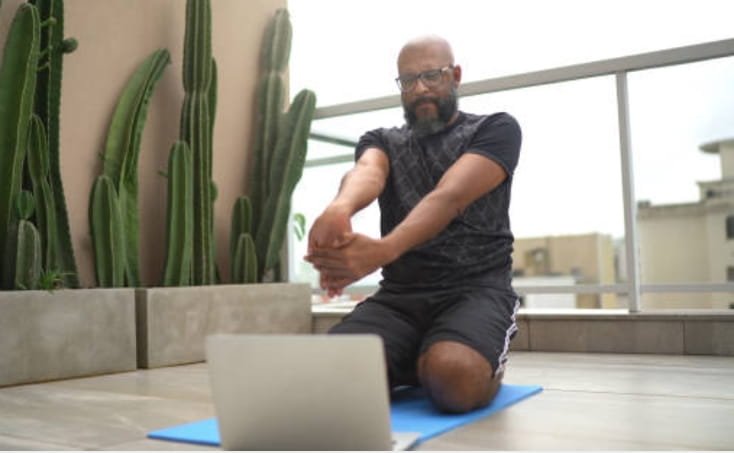
by admin | Jun 10, 2022 | Workouts
Training For Men Over 40 | Why & How You Should Train
Most men are scared of aging but if you do the right things, you won’t “get older” but you’ll rather age well like fine wine. Naturally, as men age, testosterone levels go down and that leads to a change in the mental and physical state.
In this article, we’ll reveal the benefits of training into your older years and tell you exactly how you can approach this, in order to reap long-lasting benefits.
Why You SHOULD Train In Your Older Years

“I don’t train, I’m already old and the results are way slower than they would if I had started young…”. This is one of the most common excuses you hear from men over 40, which they use to justify the lack of movement in their life. Well, though this is a common belief, the fact of the matter is that while the response may not be as prominent, training is still a good stimulus regardless of age.
Whether you’re 15, 25, or 40+, including certain types of training in your lifestyle, will increase your health and improve the overall quality of life. More specifically, strength training has been proven to be a good anti-aging tool, which helps maintain normal testosterone levels. So again – You’re helping your body as time goes by and by maintaining it, you bring a healthy, functional, good-looking body into your older years.
What Training Should You Do?
When it comes to training, it is a fact that exercise relies on principles, which makes the end result predictable. There are different types of training which in turn, bring different end results, so let’s analyze the most common types of training you can take on.
Strength Training

The goal of training is to usually get the best out of it, whether we’re talking about how you look, perform or feel. After 40, it is likely that you won’t be after a competitive sports career, so naturally, you’d be more inclined to do training that focuses on overall development and wellbeing.
Strength training is the type of training you should focus on if your goal is to:
- Improve strength
- Look better
- Feel better
- Optimize testosterone production
- Be more athletic overall
As we already mentioned, strength training is literally the fountain of youth for men over 40. This is due to the fact that this type of training causes a strong anabolic (constructive) response in the body, making it a nourishing activity for practically your entire body and mood. With strength training, you will observe improvements in strength & strength endurance, muscular tone, overall mood, sex drive, and overall athleticism.
As an adult man, this is the type of training you should primarily focus on.
Cardio training

Low-intensity, prolonged sessions are referred to as “cardio” and are the type of activity that most often comes to mind when you think of “training”. This type of training has its benefits, which are primarily expressed in the increased efficiency of your heart & lungs.
Cardio training is the type of training you should go for if you’re looking to:
- Increase endurance
- Improve heart & lung health and function
- Burn some extra calories
- Be healthier overall
The thing about prolonged cardio is that it causes the release of cortisol, which in turn may lower testosterone levels.
This is why it is recommended to do some cardio but not too much and instead, focus most of your energy on your strength training sessions. Cardio is optimally done after strength training, for 20-40 minutes at a moderate pace. Including regular cardio in your routine may improve muscle tone, overall health & mood.
Frequently Asked Questions
What we said above is very generic and it just displays the benefits of different types of training you can do. Now let’s get a little more specific and dig into the details which can help you set up a training plan.
#1 What type of strength exercises should I do?
The goal with strength training is to create a stimulus that is as prominent as possible. Compound exercises that involve more than 1 joint and muscle group at a time, are your best choice, whether you’re a young or adult male. These are exercises like squats, deadlifts, bench presses, overhead presses, pull-ups, dips and other dumbbell, barbell & kettlebell exercises.
Such movements will allow you to lift significantly heavier weights, due to the greater amount of muscle fibers engaged. This will therefore create a greater stimulus & biological response but then again, you shouldn’t lift too heavy, as you want to sustain this performance and avoid injury.
#2 How many sets and reps should I do?
The question of sets and reps is controversial and you can easily get misinformed but the fact of the matter is that the number of sets and reps depends on the goal you want to achieve. You want to increase your maximal strength? Focus on 1-5 reps (powerlifting range) You want to create the most visually appealing physique? Focus on 5-15 reps (bodybuilding range).
Ultimately, your best bet would be to combine both the powerlifting & bodybuilding range, as that will allow you to stimulate the muscles across all their properties (strength, strength endurance, explosiveness, etc.) As to the number of sets, it is generally best to start off at 5+ working sets per muscle group per week (as a beginner) and increase that number as you progress, up to 10-20+ challenging sets.
#3 How often should I train?
When you workout, you do micro damage to your muscles and so, you need to carefully manage your recovery between workouts, in order to perform at your best from workout to workout. Generally for strength training, optimal recovery comes around the 48th-96th hour after training.
Basically, you should train each muscle group again, when it is at its peak recovery state (48th-96th hr after a workout). Think of it this way – Since your performance declines after a certain point in your workout, it is best to do 2 workouts with 5 working sets, rather than 1 workout with 10 sets.
Why? Because it would realize a greater total working volume (total amount of weight lifted) and thus, create a more powerful stimulus for the body.
#4 What type of cardio training should I do?
Cardio is a great tool to use for recovery, unwinding and relaxation when you’re not in the gym lifting weights. This type of training implies a low-intensity, prolonged training session and there are MANY such activities. We’d advise you to avoid limiting your cardio to just the treadmill.
Instead, do some running outside, ride your bicycle, do some swimming, some rope jumping or even some quick walking. These activities are best done after strength training or on your off days. If your goals primarily resonate with what strength training provides as an end result, you shouldn’t do too much cardio, as it may rob you of the energy for your strength workouts.
#5 How often should I do cardio?
The last sentence of point number 4 brings us to this question but the thing is… There is no definitive answer. But we can say this for sure – If you are primarily looking for increases in strength, strength endurance, muscular tone & testosterone production, overdoing cardio can be suboptimal.
We’d generally recommend doing 2-4 cardio sessions per week, lasting ~40 minutes. These are done after your strength workouts, or on days when you don’t go to the gym. We are not completely signing cardio off, as it is highly beneficial for the heart, lungs and your overall health. It can even be used as a great tool to recover from strength workouts.
All we’re saying is – If you do a lot of cardio, make sure you’re also eating more nutrient-rich, whole foods that provide all nutrients to the body.
You’ll need that energy!
Conclusion
As men age, testosterone levels naturally decline and so, training can be used as a tool to mitigate the effects of getting older and help you age like fine wine. If you’re an adult male, you should primarily focus on strength training, taking on compound, heavy exercises that engage more muscles at once.
The exertion should be moderately high and hard failure must not be reached too often, as that may increase the chance of injury or physical burnout. Ultimately, you should be looking to mix strength & cardio training, along with recovery practices like stretching & massages. Think of it as using the body every day and doing some activity regularly, even if it’s for 15-30 minutes only.
Movement is energy and so, if you want an optimally-functioning body as an adult, you should do your best to keep your body active & healthy, through training and nutrition.

by admin | Jun 10, 2022 | Health, Mind
Tricks to Prevent Stress or Sadness-Triggered Shopping
How often has your bank account suffered because your boss pissed you off, or you were going through a tough break-up, moved to a new place, lost a friend? It isn’t an urban myth. Some people seek instant pleasure in shopping whenever they feel bad and lonely.
However, sadness-triggered shopping isn’t good for your wallet, and let alone your mental health. Before we discuss ways to prevent shopping when you feel bad, let’s look at why this type of shopping is unhealthy.
Why is Sadness-Buying Bad for You?

The things you buy impulsively are often inexpensive, in mid-range from $40 – $100. But, despite the costs, impulse buying is your enemy number one if you are looking to save some money. On the other hand, the items you buy impulsively only provide a short-term feeling of happiness. They won’t fix the problem you have or make you feel good about yourself. Also, some people feel guilt after impulse buying, which gets them in a never-ending loop of impulse, stress-triggered shopping. First, they feel bad.
Then, they buy items to make them feel better. Once they can think clearly, those people might understand why the bought items are unnecessary and not money-well spent. Then, they feel bad again for not being able to control their emotions and credit cards. Some may even buy new items to make them feel good. The circle continues, and people aren’t even aware that they are in the loop. Stress-triggered shopping masks the real issue you are going through, and they prevent you from dealing with it and confronting your emotions.
How to Prevent Yourself from Buying out of Sadness?

Embrace your feelings and allow yourself to feel sad for the moment. Don’t seek short-term pleasures. A study showed that sadness makes people spend more, so think about what you would do better with your money instead of spending it on meaningless items. Restraining yourself from shopping when you are said, is a huge step. So, the next section is for you.
Stay in Charge of Your Wallet with the Next Tips

Here are some tips to help you overcome your urge to click Add in the chart whenever you feel lonely or sad.
#1 Clean
Cleaning your home or workspace is an effective way to distract yourself from choosing new clothes and shoes. Get your hands dirty, and thoroughly clean your kitchen, bathroom and closet. Go through your makeup collection and declutter. Get rid of all unnecessary items, and you’ll feel you have more space to breathe and feel better.
During the process, you’ll discover some items you might have forgotten about!
#2 Call a Friend
Before you decide to spend money, call your friend and discuss whether it is a good idea. That way, you’ll delay your impulse decision to buy new things, so your mind might get clearer. Hopefully, your friend will advise you against unnecessary money spending. You’ll also get a chance to discuss the real reasons behind your impulse urge to shop with someone who you have trust in and who you love.
#3 Do Self Care
When you’re in a bad mood, putting on a face mask and relaxing in the tub will make you feel as good as if you’ve just purchased a new pair of shoes. On top of everything, you’ll get a chance to calm down and reflect on your current situations and thoughts.
Not only will it delay the impulse for shopping, but it can also help you understand why it isn’t a good idea, or what you can do to help yourself in the long run. Do you buy when you’re sad? What is most ridiculous item you bought out of sadness and loneliness?
Please consider liking the article if you enjoyed it!

by admin | Jun 10, 2022 | Mind
Questions You Should Ask Yourself If You Want To Be A Psychologist
The First Steps On The Road To Your Dream Job Psychology is one of the fields of study and respectively work with the most widespread uses and applications. As such, the job opportunities regarding it are countless – anything from a forensic expert to a social media creator can benefit from the knowledge and/or a degree in psychology.
If we talk about more conventional types of work in this field, most people presume that psychologists deal only with mentallly ill patients and do so in their offices or in recovery facilities. This is far from true, though, and the sooner you have a clearer vision of the employment possibilities, the easier it will be to make your choice.
Here are some of the vital questions you should ask yourself if you want to work in psychology.
What Field Of Psychology Are You Most Interested In?
Psychology has many facets.
As such, it’s important to know what you find most interesting and what you think you’d be best at when looking for specific job options. Some of the most popular types of work are clinical (dealing with patients) and social (work in different groups and organizations that are connected to people) psychology or research (studying and producing content in the various fields of psychology).
There are a lot of different fields that are still connected to psychology, too (law, HR, and media). Because psychology deals with a huge portion of the world, it has many uses and applications in modern society which is great but can be a bit overwhelming. You should make sure your focus is generally speaking regarding one subject and that it’s something you really find interesting.
From there, it’s much easier to take the next steps.
Do You Want To Do Research Or Work With Clients?

When talking specifically about the most conventional type of psychology, it’s largely separated into two kinds. Research deals with collecting, analyzing, and drawing conclusions from data gathered either by you or by someone else. Most people would agree that this is the more cut-and-dry type of work between the two.
The other is dedicated to helping people first-hand. Whether you deal with people who are healthy or those who have some issues is completely up to you, but close work with individuals and groups is the main focus in the second option.
Do You Want To Work In A State Job Or Individually?

There are many different opportunities for people who want to work for their country. Counselors, forensics and criminal psychologists, public relations psychologists, and many more are state jobs that either require or benefit from a psychology degree.
If, however, you would prefer to have an organization on your own, that’s completely possible as a psychologist. Many experts have their own firms and growing companies. Apart from being a clinical or educational psychologist, you can also have your own company in marketing, media, or social services.
Do You Want To Work With Kids?
Working with kids is an entirely different aspect of psychology. You can be all sorts of an educational figure for both separate kids or groups as a psychology expert. A lot of people consider working with children to be very difficult, seeing as this is one of the most responsible positions in society, because of the lasting effects it can have on the future.
However, some people have a talent in this area and find the work extremely enjoyable and gratifying. If you’re from the second type, then you should consider working with kids. Teachers, social workers, or art and sports educational psychologists are all possible options if you want to benefit from your knowledge in psychology.
There is also the option to help children with issues as well as their parents, which oftentimes has a huge effect on their future lives.
Conclusion
Psychology as a field has numerous applications in society, and as such, it is full of different job opportunities. Depending on what you choose your future profession to be, you will need to do some research on what sort of degree and documents you need and how to best go about acquiring them in the country of your choice.
After that, you can start working with the proper tools, and you’ll already be on your way to having exactly the job you want. If you make the right choice for you, psychology can be one of the most fulfilling fields of work. So start doing your research, and best of luck!

by admin | Jun 10, 2022 | Fitness
How To Lose Weight & Keep It Off | Part 1 – Nutrition
If the question at hand is losing fat and keeping it off, most people would search for an easy solution, such as a weight loss pill or a promising program a famous coach made for everyone.
The truth however is that an approach like this more often leads to eating disorders and loss of motivation, rather than sustainable results. Think of it this way – Your body is a machine and its YOUR responsibility to understand how that machine functions and what you can do to maintain it.
In this article, we’ll give you the best tips you can use in your daily life to start cutting weight (and keeping it off).
The Modern-Day Problem

Humans have existed for hundreds and thousands of years and for most of that time, we as a species have gone through starvation. Starvation is something the body knows very well and that is the reason why it can go through metabolic adaptations, which allow it to survive on little to no resource.
And here comes the big but…
It’s only been the past 30 years of human existence (out of 200,000+), that we’ve had such easy access to a multitude of foods. Furthermore, those foods, many of which are bad, can be delivered right to your door, without having you do anything else besides standing up to pick up your delivery. If we follow that train of thought, we can conclude that the modern-day lifestyle is quite literally, fattening!
At its very core, it robs you of movement and gives you a ton of junk food to choose from. What we’re trying to tell you here is that the very first steps you should take towards your weight loss journey, is to take care of your physical activity levels, as well as your nutrition
Fat Loss 101

The fundamental principle of weight loss is referred to as “eating in a caloric deficit”. This essentially means giving the body a lesser amount of energy (food) than it needs to sustain its body weight. What this means for you is that the primary factor for weight loss is the AMOUNT OF FOOD and not so much the type of food. (Yes, you can lose weight with burgers.)
Now, the amount of energy you need daily to maintain your body weight and bodily functions, is referred to as “Total daily energy expenditure (TDEE)”. Your TDEE is individual and it depends on the following factors:
- Gender
- Age
- Height
- Weight
- Non-exercise activity
- Exercise activity
- Food consumption (digestion uses energy)
Quite simply, if you consume more than your TDEE, you will gain weight.
If you consume less than your TDEE you will lose weight and if you’re around your TDEE, no massive changes in weight will be observed.
You can calculate your own TDEE using this weight loss calculator – https://www.traininginthebay.com/macro-calculator/
NOTE: No TDEE calculator is 100% accurate so don’t take these results for granted – Monitor your progress and adjust along the way.
Macronutrients
Now, though you can eat any food on a diet and still lose weight, the choice of food sources is important. During a period of weight loss, you lose not only fat but also lean body mass (LBM). In order to avoid a biological disaster, you MUST do everything possible to retain that lean body mass.
The first thing is to secure a moderate caloric deficit, made up of complete, nutritious food sources with sufficient amounts of protein and fats. The second thing is to secure enough energy (carbohydrates) for good training sessions. Finally, you have to make sure that your rate of weight loss is adequate, at around 1-2 lbs per week – This will ensure that most of the weight you lost is fat.
Not only that but with a moderate deficit, you will still be able to sustain the healthy functioning of your body and you will also have enough energy for any daily activities. So to put it simply – If you are in a moderate deficit and primarily eat nutritious foods and train well, you will be able to retain most of your lean body mass and your energy levels will be high.
In terms of quantities, this is how you can spread your macros across the nutrition plan: Protein (4 calories per gram) – 0.8-1g per lb of body weight. Fat (9 calories per gram) – 0.35-0.45g per lb of body weight. Carbohydrates (4 calories per gram) should make up the remaining caloric intake.
Example:
- If your TDEE is 2200 calories, you’d need to consume 1700 calories to burn fat.
- If you’re 180 lbs, that would mean you’d need about 180 grams of protein and 60 grams of fat
- 180 grams of protein are 720 calories and 60 grams of fat are 540 calories, making a total of 1260 calories
- 1700 calories – 1260 calories = 440 calories remaining
- These 440 calories go for carbs and to calculate the exact amount, you simply divide by 4 because carbs have 4 calories per gram (110g of carbs are 480 calories)
Keeping the weight off

Alright, so we now know that a moderate deficit that favors nutrient dense-foods is the best way to sustainable fat loss. But how do you actually keep the weight off? The majority of people who go on a diet, re-gain 100% or more of their weight back in twice as less time as it took them to actually lose it…
And this is the EXACT reason why you shouldn’t think of your diet as something that has a start and end date. It is a healthy habit that you should create and keep with you for the rest of your life, in order to meet the needs of your organism. If you want to keep the weight off, after you’ve hit your goals, do the following:
- Reverse dieting – Gradually increase caloric intake by 50-80 calories per week
- Keep monitoring weight – You shouldn’t gain weight drastically.
- Continue training – Increase your working weights, sets and repetitions
Additionally, throughout the period of eating at a caloric deficit, you should resort to diet breaks every 2-3 weeks. This essentially means going back to maintenance calories and what this will do is it will help you keep your metabolism up, making the whole process more bearable.
Conclusion
Losing your fluff and keeping it off starts at the very fundamentals of what you put in your body. To achieve sustainable weight loss, you must resort to a moderate caloric deficit and nutrient-dense foods. Remember this should not be a drastic, quick process but rather a gradual change in time. In the second part of this article series, we’ll tell you more about training and how you can use it to speed up your fat loss and keep the body healthy.

by admin | Jun 10, 2022 | Diet
Starting A Diet? Consider These Important Factors!
Remember that time you started a diet and everything was going great? You were eating all the right things, working out hard, and seeing results.
And then… you hit a wall. Suddenly, your progress came to a halt, and no matter what you tried, you couldn’t seem to break through. It’s easy to blame yourself in those situations, but there are actually a few things you should consider before starting your next diet. In this blog post, we’ll explore some of those important factors, so without further ado, let’s dive straight in!
#1 The Deficit

We’ve heard it many times – Someone goes on a diet only to have 12 weeks of torture and little to no results. What comes after that is usually the phrase, “Man, I busted my butt on this diet for three months straight and only lost 2 lbs. It even turns out this was just water!” And well, when we talk about diets, it’s not just about how consistent you are, but about the underlying, fundamental principles of a weight loss diet.
If you want to lose weight, the first and most important thing is creating a caloric deficit. That is, consuming fewer calories than your body needs to maintain its weight. If you don’t have that checked, it doesn’t matter if you do fasting, keto, vegan, or carnivore – You won’t lose weight.
#2 Sustainability

Now, certainly, though losing weight means ‘looking better’ for us, the body thinks differently. For the body, weight loss equals starvation, and therefore, it will do everything in its power to get back to normal. You’ll feel lethargic. You won’t have energy. You’ll have cravings. You might even be hungry all the time.
However, you have to find a sustainable way of dieting that minimizes all of those and allows you to still have energy for all your activities and errands while not thinking about food all the time. The first thing towards achieving this is to establish a moderate caloric deficit of up to 500 calories per day. This will ensure that you are still getting enough energy to provide your body with everything it needs to maintain healthy functioning and regulate cravings.
The second thing is…
#3 Protein & Fats!

The persistent hunger and rush of cravings is something many of us experience, even out of a diet. But on a diet, it is even more prominent, meaning that one of the best ways to make a diet sustainable is to find a way to regulate appetite and cravings. In other words, your goal is to be constantly satiated to the best extent possible, so the body won’t look for more food.
How can you do that? Well, by consuming sufficient, quality protein & fats! Protein and fats are the two most satiating macronutrients we get from foods. However, there is one underdog food that has the HIGHEST satiety index amongst all foods – Potatoes! So hey, next time you decide to start losing weight, have a steak & potatoes for breakfast and see how long that will keep you satiated!
#4 Don’t Forget Carbs
Nowadays, carbohydrates are often demonized because misinformation has led people to believe that carbohydrates are the primary reason for weight gain. And while that isn’t really true, there is the fact that carbs are also the PERFECT source for training activity. Not only that, carbohydrates are the preferred energy source for the brain, as well.
#5 Do Resistance Training
With the above said in mind, one should also consider resistance training while losing weight (fueled with carbs;)Why? Because when losing weight, we lose not just fat but also muscle mass, which may ultimately lead to a skinny-fat rather than an aesthetically sculpted physique. So first off, resistance training will allow you to retain your muscle mass, and second of all, it will give you a major boost towards the ultimate goal of weight loss – Looking better.
Not to mention the benefits resistance training has for your mind and overall performance…
Final Thoughts
So there you have it – If you’re starting a diet, you have to make sure that you are in a sustainable caloric deficit that still provides you with all the energy you need daily! Remember, if a certain diet plan feels like torture, it’s time to change things up. You MUST be able to adhere to your plan and stick to it in the long term because this is what brings the best results!

























